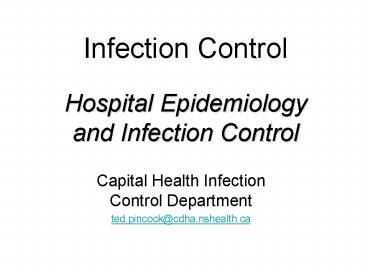Infection Control - PowerPoint PPT Presentation
1 / 18
Title:
Infection Control
Description:
Identify primary measure to reduce HCAI. Discuss 4 modes of ... Gowns. Masks & Eye protection. Accommodation. Patient Care Equipment. Environmental Controls ... – PowerPoint PPT presentation
Number of Views:629
Avg rating:3.0/5.0
Title: Infection Control
1
Infection Control
Hospital Epidemiology and Infection Control
- Capital Health Infection Control Department
- ted.pincock_at_cdha.nshealth.ca
2
Lecture Objectives
- Scope of Infection Control Practice
- Health Care Associated Infections
- Infection Control Guidelines
- Infection Control in Clinical Practice
3
Expected Outcomes
- Identify 5 Health Care Associated Infections
- Quantify annual impact of HCAI in Canada
- Identify primary measure to reduce HCAI
- Discuss 4 modes of infection transmission
- Discuss role of Infection Control Dept
- Discuss the significance of infection control in
clinical practice
4
Healthcare Infection Facts
- An infection in hospital
- increases length of stay by 4 - 7 days
- increases pain and suffering which, in turn,
- increases the need for additional drugs,
treatments or surgeries - All, of which, increase the cost of Healthcare
5
Healthcare Infection Facts
- Health Care Associated Infections (HCAI) kill
8,000 12,000 Canadians every year
It is estimated that between 1/3 1/2 of
all HCAIs are preventable - Hand hygiene is the primary measure to reduce
HCAIs and the spread of AROs - HCW compliance with hand hygiene considered to be
less than 40
6
The Role of the Infection Control Department
- Hospital Infection Control Department is
responsible for instituting and maintaining an
evidence based Infection Control Program which
assists healthcare providers improve patient
outcomes by - establishing surveillance measures to identify
Health Care Acquired infections - providing prevention, containment control
measures that reduce the probability of
occurrence of infection.
7
Infection Control Practitioner
- Patient Surveillance
- Monitor Patient Outcomes Record HCAI data
- Educator Promoter of safe clinical practice
- Not an ENFORCER
- Outbreak Investigation Management
- Contain control transmissible infection
- Research Analysis of HCAI data
- Provide feedback for evidence based change
- Board Certified (CBIC - North American Body)
8
Five Notable Healthcare Associated Infections or
(HCAI)
- Blood Stream Infection (BSI)
- Pneumonia (HCAP or VAP)
- HCAP Health Care Associated Pneumonia Duhh!!
- Surgical Site Infection (SSI)
- C. difficile Associated Diarrhea (CDAD)
- Urinary Tract Infection (UTI)
9
Infection Control GuidelinesFocus - Patient Care
- Hand Washing
- Gloves
- Gowns
- Masks Eye protection
- Accommodation
- Patient Care Equipment
- Environmental Controls
10
Routine Practices and Additional Precautions for
Preventing the Transmission of Infection in
Health Carehttp//www.phac-aspc.gc.ca/publicat/cc
dr-rmtc/99vol25/25s4/index.html
- Additional Precautions
- based upon modes of microbial transmission
- also known as Transmission-based precautions
11
4 Modes of Transmission
12
Additional Precautions
- Contact Precautions
- Direct Contact
- Skin to skin Infected individual gt susceptible
host - Indirect Contact
- Passive transfer of microbes to a susceptible
host - Droplet Contact
- Contact transmission but requires different
precautions
13
Remember The 4 moments of Hand Hygiene
14
Additional Precautions
- Droplet vs. Airborne Precautions
- Droplet Precautions
- Microbes in droplets (gt 5 micron diameter) fall
out of air - Droplet Zone defined as 1 metre from source
- Airborne Precautions
- Microbes in droplet nuclei (lt 5 micron) stay
suspended - Droplet nuclei or dust particles with skin
squames or debris
15
The Risk We Run
- Following Routine Practice Additional
Precautions further lowers the risk of
transmission and infection - Poor or inappropriate practice increases the risk
of transmission and subsequent infection for - your patients / clients
- you and your colleagues, family friends
- In addition, patients (already at greater
infection risk) have a right to safe, ethical
care. This not only requires but demands safe
practice.
16
Why are patients at greater risk?
- Patients are
- Unwell to begin with
- Normal flora altered
- Exposed to risk by Healthcare System Healthcare
Providers
17
The Added Burden Antibiotic Resistant Organisms
- Microbial evolution Increased resistance
- MRSA
- Methicillin-Resistant Staphylococcus aureus
- VRE
- Vancomycin-Resistant Enterococcus
18
Forestalling Evolution through Evolution of Our
Practice
- Practice modifying your technique to comply
with recommended guidelines - Remember each patient space is a microcosm of
transmissible organisms - Hand Hygiene is a visible indicator of your
safety as a healthcare provider































